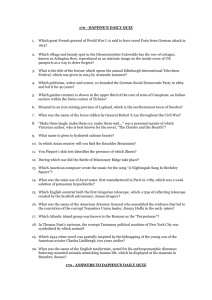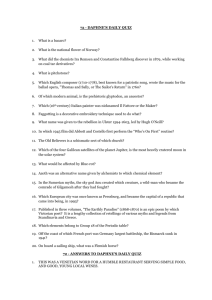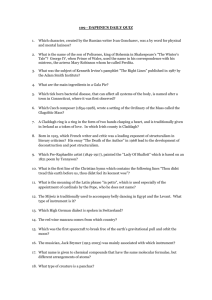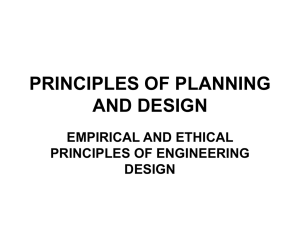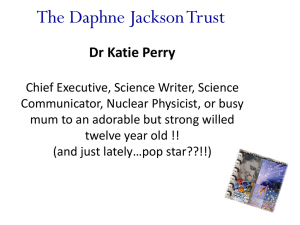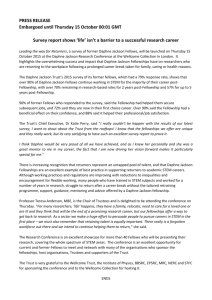WELNS 670_Ch3
advertisement
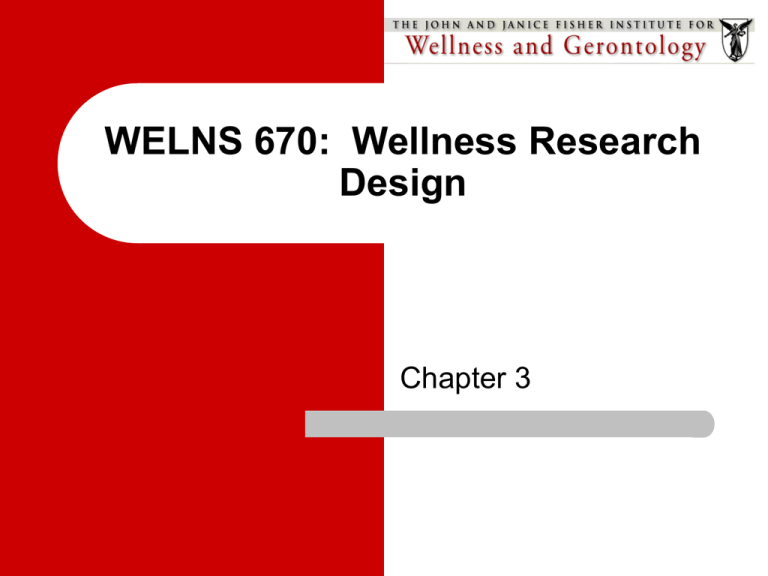
WELNS 670: Wellness Research Design Chapter 3 The Problem: The Heart of the Research Process Chapter 3 A Suitable Research Problem… Addresses an important question such that the answer makes a difference Advances knowledge by leading to new ways of thinking, suggesting possible applications, or leading to additional research Identifying a Problem Look around you Read the literature Attend professional conferences Seek the advice of experts Choose a topic that intrigues and motivates you Choose a topic that others will find interesting and worthy of attention Things to Avoid when Considering a Problem for Research The goal of the research should not be selfenlightenment Go beyond comparing two sets of data Showing relationships exist is not the same as trying to determine why relationships exist Ask more then a yes / no question Steps to follow State the problem clearly and completely… one or more grammatically correct sentences – Provides both focus and direction for your research Think through the feasibility that the problem implies Say precisely what you mean Edit your work, choosing your words carefully Checklist Write a clear statement of the problem for research Review your written statement and ask yourself the following questions: – – Is the problem stated in a complete, grammatically correct sentence? Is it clear how the area of study will be limited or focused? Edit your statement Checklist (continued) Look at your edited statement and reflect on the following questions: – – – Does the answer to this problem have the potential for providing important and useful answers and information? Will the results be more than a simple exercise in gathering information, answering a yes/no question, or making a simple comparison? Is the problem focused enough to be accomplished with a reasonable expenditure of time, money, and effort? Looking at the statement once more, consider this: Is the problem really what I want to investigate? Checklist (continued) Share your research with other students and ask them to consider the two sets of questions Use all of the feedback received to edit and rewrite your problem statement Group Project Problem: Group Activity Formulate a formal statement of a research problem. Consider the importance and practicality of the general problem. Subproblems Are they really subproblems (and not a “how to proceed problem”)? Is each a completely researchable unit? Is it clearly tied to the interpretation of the data? Do the subproblems add up to the totality of the main problem? Are they few in number? Group Project Problem and sub-problems: Group Activity Formulate a formal statement of a research problem. Consider the importance and practicality of the general problem. Identify sub-problems. Further delineation State the hypotheses and/or research questions (tentative intelligent guesses/no speculative answers) Delimit the research (What this research is NOT going to do) Define the terms State the assumptions (What am I taking for granted with respect to the problem?) Identify the importance of the study Group Activity Formulate a formal statement of a research problem. Consider the importance and practicality of the general problem. Identify sub-problems. Pose questions, define terms, and state assumptions. Questions… Why is it important that the researcher articulate, as clearly as possible, all assumptions that effect the research problem? Why do you think it is important to define any terms that might be misunderstood by someone reading the research proposal? Discussion… Daphne has been a member of a research team studying interpersonal aggression among pre-schoolers for more than a year. In tat time, her team has repeatedly employed a consistent set of techniques and procedures to study pre-schoolers as they interact in a number of settings. The procedures revolve around volunteer mothers bringing their children to the university child development lab for a “play session” that is the basis of the formal observations. Settings they have studied so far include: the university preschool, affluent local day care centers, and a pre-kindergarten program being offered in the neighborhood school district. All of these settings were fairly racially homogenous. Daphne has just learned that a friend of a friend can help her gain research access to pre-schoolers in an unusually racially diverse though impoverished pre-school setting in the near future. Daphne decides she has no time to prepare a formal research proposal before embarking on the study. “Besides,” she thinks, “this study should go just like all the others we’ve done.” Is Daphne leaving herself open to problems in this situation, or is she safe moving ahead with no formal proposal given how familiar she is with the study techniques and procedures? Project Work Literature Review Understanding the Role of the Literature Review It will increase your confidence in your topic if you find that others have an interest in this topic and have invested time, effort, and resources in studying it. It can provide you with new ideas and approaches that may not have occurred to you. It can inform you about other researchers conducting work in this area. It can show you how others have handles methodological and design issues in studies similar to your own. It can reveal sources of data that you may not have known existed. It can introduce you to measurement tools that other researchers have developed and used effectively. It can reveal methods of dealing with problem situations that may be similarities to difficulties you are facing. It can help you interpret and make sense of your findings and, ultimately, help you tie your results to the work of those who have preceded you. Group Literature Review Find and copy each article Attach a completed review form to the front of each article Turn in articles (hard copy) on October 7 Talk to me if you have trouble finding an article… Begin collecting articles for your individual study Keep track of the search terms you used and the databases searched (this information is important to include at the beginning of your review)
